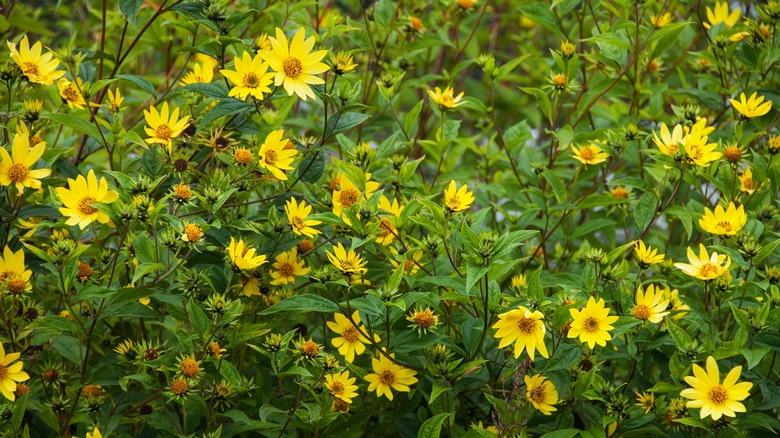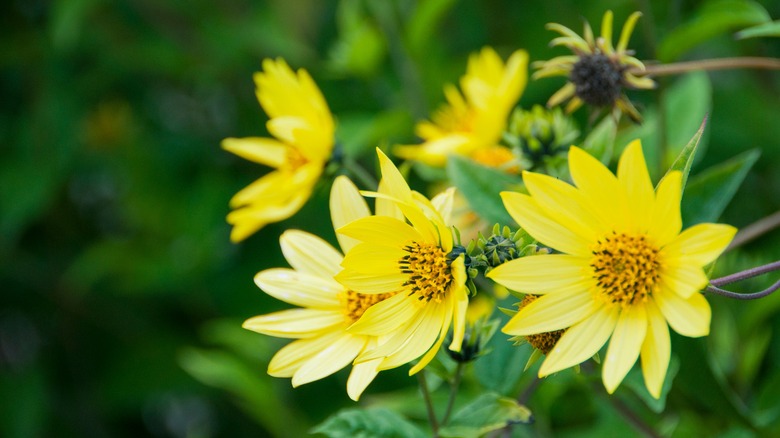The Small But Mighty Sunflower Variety That Can Thrive In Extreme Conditions
Do you want to add a touch of sunflower charm to your garden but don't want to grow a massive flower? If so, look to the Helianthus microcephalus, commonly known as the small-head sunflower. This is a powerhouse plant that thrives in a variety of conditions and possesses several distinct visual characteristics that set it apart from other varieties.
This perennial sunflower is renowned for its smaller stature when compared to other types, typically reaching heights of 4 to 6 feet. Its slender, branching stem bears narrow, lance-shaped leaves with serrated edges. The foliage is typically a rich green shade, providing an appealing backdrop for the vibrant blooms. What truly distinguishes Helianthus microcephalus flowers are their small, compact blooms. These dainty sunflowers measure only 1 to 3 inches in diameter, which is quite small compared to the colossal heads of many of their cousins. The central disk is brown, while the surrounding ray florets are typically a bright yellow, creating a striking color contrast.
The miniature size of the blooms makes this flower a perfect fit for modest gardens, borders, and containers, or anywhere where larger types might be overwhelming. Its smaller flowers are also a delightful addition to cut flower arrangements. Furthermore, this sunflower's ability to adapt to a wide range of conditions, coupled with its minimal maintenance requirements, makes it an attractive choice that doesn't come with lots of demands. In comparison to the more traditional giants, Helianthus microcephalus stands out as a more manageable, space-efficient option.
Why it grows well in extreme conditions
Helianthus microcephalus, along with many other types of sunflowers, possesses unique adaptations that enable it to thrive in extreme conditions. First, it has a remarkable ability to withstand drought. Its deep and robust root system allows it to access moisture from lower soil layers, reducing its dependence on surface water sources. This adaptation ensures its survival in arid and water-scarce environments. Moreover, this species and other sunflower types exhibit a decent degree of heat tolerance, provided they have enough access to moisture and regular watering. That being said, their desired temperatures range between 70 and 78 degrees Fahrenheit for them to thrive.
Helianthus microcephalus can grow in a variety of soil types including nutrient-poor and well-drained soils. Its ability to thrive in less-fertile soil allows it to colonize a broad range of habitats including dry meadows, rocky hills, and frequently-trafficked or disturbed areas. Overall, Helianthus microcephalus exhibits remarkable adaptability, enabling it to endure and reproduce in extreme conditions. These traits have made it a resilient and successful species in a variety of challenging environments, making it an important component of many ecosystems and a great option for a variety of garden types.
How to care for your Helianthus microcephalus
Caring for a small-head sunflower in your garden is relatively easy due to its adaptability to such a wide range of conditions. Helianthus microcephalus thrives in partial shade to full sunlight, so choose a location in your garden that receives plenty of sun with little shade. This sunflower variety is not overly picky about soil type but prefers well-draining soil if possible. If your soil is heavy or clay-like, consider amending it with organic matter such as compost to improve drainage. While it is relatively drought-tolerant, it still requires regular watering, especially during dry spells. Water these sunflowers deeply, ensuring that the soil is evenly moist but not waterlogged. Also avoid overhead watering, as this can lead to fungal diseases.
Deadhead spent flowers regularly to encourage continuous blooming. This will also prevent the plant from diverting energy into seed production. Additionally, remove any yellowing or diseased leaves to maintain the plant's overall health. This sunflower is generally resistant to most pests and diseases, but keep an eye out for common garden pests like aphids or slugs. If necessary, treat with organic pest control methods or insecticidal soap. Though they are shorter, these flowers will still benefit from staking or support if grown in windy areas.


